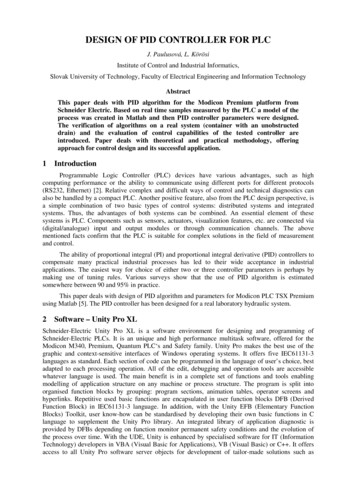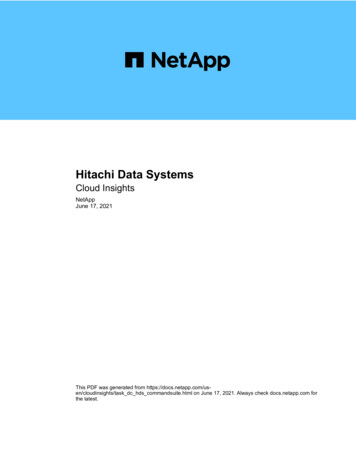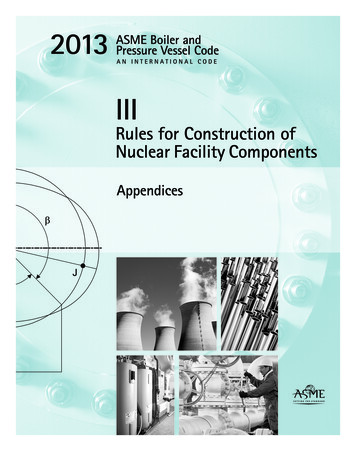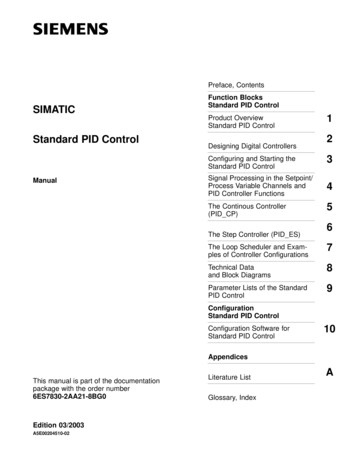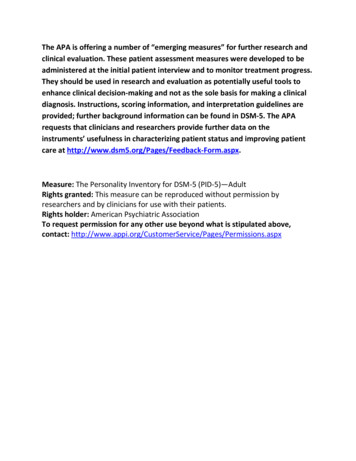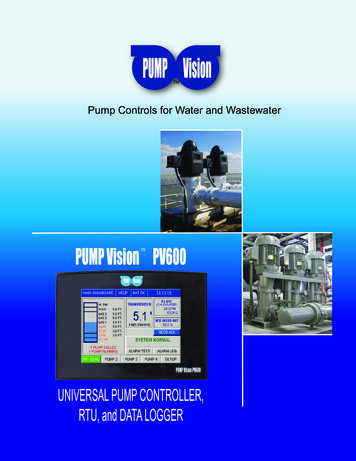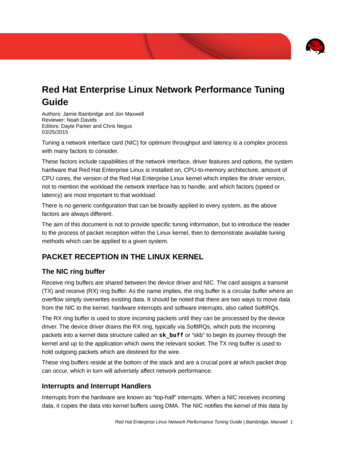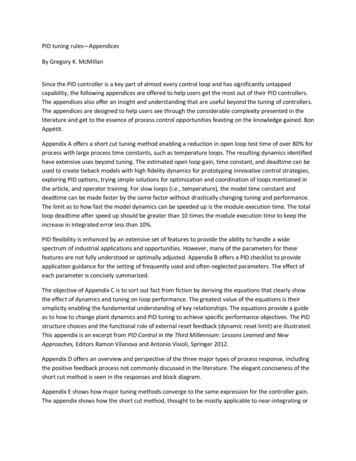
Transcription
PID tuning rules—AppendicesBy Gregory K. McMillanSince the PID controller is a key part of almost every control loop and has significantly untappedcapability, the following appendices are offered to help users get the most out of their PID controllers.The appendices also offer an insight and understanding that are useful beyond the tuning of controllers.The appendices are designed to help users see through the considerable complexity presented in theliterature and get to the essence of process control opportunities feasting on the knowledge gained. BonAppétit.Appendix A offers a short cut tuning method enabling a reduction in open loop test time of over 80% forprocess with large process time constants, such as temperature loops. The resulting dynamics identifiedhave extensive uses beyond tuning. The estimated open loop gain, time constant, and deadtime can beused to create tieback models with high fidelity dynamics for prototyping innovative control strategies,exploring PID options, trying simple solutions for optimization and coordination of loops mentioned inthe article, and operator training. For slow loops (i.e., temperature), the model time constant anddeadtime can be made faster by the same factor without drastically changing tuning and performance.The limit as to how fast the model dynamics can be speeded up is the module execution time. The totalloop deadtime after speed up should be greater than 10 times the module execution time to keep theincrease in integrated error less than 10%.PID flexibility is enhanced by an extensive set of features to provide the ability to handle a widespectrum of industrial applications and opportunities. However, many of the parameters for thesefeatures are not fully understood or optimally adjusted. Appendix B offers a PID checklist to provideapplication guidance for the setting of frequently used and often neglected parameters. The effect ofeach parameter is concisely summarized.The objective of Appendix C is to sort out fact from fiction by deriving the equations that clearly showthe effect of dynamics and tuning on loop performance. The greatest value of the equations is theirsimplicity enabling the fundamental understanding of key relationships. The equations provide a guideas to how to change plant dynamics and PID tuning to achieve specific performance objectives. The PIDstructure choices and the functional role of external reset feedback (dynamic reset limit) are illustrated.This appendix is an excerpt from PID Control in the Third Millennium: Lessons Learned and NewApproaches, Editors Ramon Vilanova and Antonio Visioli, Springer 2012.Appendix D offers an overview and perspective of the three major types of process response, includingthe positive feedback process not commonly discussed in the literature. The elegant conciseness of theshort cut method is seen in the responses and block diagram.Appendix E shows how major tuning methods converge to the same expression for the controller gain.The appendix shows how the short cut method, thought to be mostly applicable to near-integrating or
integrating processes, provides the correct PID gain for deadtime dominant processes if a deadtimeblock is used to compute the ramp rate.Appendix A – Short cut tuning methodAuto and adaptive tuning is recommended for all loops. The short cut tuning method can be used as aquick check of dynamics and tuning settings in about five dead times. The reduction in test timeafforded by this method is particularly dramatic for processes with a large process time constant(continuous temperature and composition control of vessels and columns). The dynamics identified canbe used to provide plant-wide experimental models or adapt parameters in first principle models perAppendix F in the ISA book Advanced Temperature Measurement and Control, and tune controllers viathe generalized approach discussed in the InTech article “PID tuning rules.”The changes in controller mode and output listed in the method should be reviewed by operations anddone by a control room operator. The final control element deadband noted in the method can beestimated as 0.2% for a sliding stem valve (globe) and 0.4% for a good rotary valve (ball, plug, orbutterfly) with a digital positioner. For a variable frequency drive (VFD), the deadband in the setup ofthe drive for speed control is used. The method can be automated in a DCS module to perform thecalculations whenever the change in controller output in a short time frame is large enough. The trendchart used to visually identify dynamics should have a time scale of about 20 dead times and a processvariable scale of about 50 times the noise. Consider the minimum noise to be about 0.05% of full scale.A ball park estimate of total loop dead time before any test is the sum of ½ module execution time,valve pre-stroke dead time (e.g., 0.2 sec), transmitter damping setting (e.g., 0.2 sec), and the processdead time. The process dead time for level includes the effect of sensor sensitivity limit and noise.Process typeProcess dead timeProcess time constantPipeline liquid pressure0.1 sec0.1 secPipeline gas pressure0.5 sec10 secVessel pressure1.0 sec50 secColumn pressure5.0 sec20 secLiquid flow0.2 sec0.5 secVessel level50 sec0.0001/sec (integrating gain)Column level10 sec0.001/sec (integrating gain)Vessel temperature2 min100 minColumn temperature40 min200 min
Vessel composition1 min50 minColumn composition40 min200 minFor at line analyzers, you need to add the sample transportation delay, 1.5 times the analysis cycle time,and the multiplex time to the total loop dead time. The module execution time should be less than 2%of the total loop dead time so the increase in integrated error is less than 10%.Short cut tuning method procedure:1. On the trend chart, find the measurement noise amplitude by momentarily putting the PID inmanual and estimating the amplitude of deviations over a period about equal to the dead time.2. With the PID in auto, add a process variable (PV) filter to keep the fluctuations in the PID outputwithin the final control element deadband.3. On the trend chart, find the largest positive and negative deviation of the PID output thatcompensates for process disturbances. Propose to operations a test step size depending ondirection that is comparable in size to the largest deviation and at least five times larger than thefinal control element deadband. The objective is the largest test step size that is not toodisruptive to process conditions. Explain to operations that the PID will be returned toautomatic after a time period that corresponds to about five dead times (state actual estimatedtime rather than using the term “dead time”). Choose for the first test a step in the leastdisruptive and safest direction.4. Put the PID manual and make the step change in the PID output with the agreed upon size anddirection. Put the PID back in last mode (e.g., Auto) after about five dead times.5. Note the time from the change in manual output to a change in the PV output of the noise bandas the dead time (θo).6. Note the maximum % change in the process variable ( %PVmax) in one dead time interval. Lookfor the maximum change over at least four dead times. Divide this maximum % change in onedead time by the dead time to get the ramp rate and then by the % change in controller output( %CO) to get the “pseudo integrator” or “near integrator” gain (Kc %PVmax/θo / %CO).7. If further testing is permitted, do a step in the opposite direction with a step size that is the sumof the allowed positive and negative step sizes using the procedure listed in items 4-6. If furthertesting is permitted, repeat this step in the opposite direction, and then do a step to get back tothe normal operating point (initial controller output before tests).8. If the complete change in the PV occurs within the first dead time interval after the start of theresponse, the process is dead time dominant. For temperature loops, if the PV change in thefirst dead time interval is 5% to 20% of the maximum PV change in subsequent dead timeintervals, a secondary time constant can be considered to exist that is approximately equal tothe dead time (τ2 0.5 θo ), otherwise the secondary time constant can be considered to benegligible (τ2 0 ). Note that the primary time constant (τ1 ) also known as the open loop timeconstant (τo ) for a “near-integrating” or “pseudo-integrating” process can be estimated byEquation A-6.
If the first step is positive (S1) and the second step is negative (-S2), Step 1 is S1, Step 2 is -S1- S2, Step 3 isS1 S2, and Step 4 is -S2 (back to original controller output).The PID controller gain (Kc ), integral time (Ti ), and derivative time (Td ), can be estimated as:Kc 0.5θo Ki(A-1)To avoid slow oscillations in an integrating process from too much reset action:Ti 2Kc Ki(A-2)If we substitute Equation A-1 into A-2, we have an integral time useful for 99.99% of the loops:Ti 4 θ o(A-3)If the process variable can develop a runaway acceleration from positive feedback, such as temperaturecontrol of highly exothermic polymerization reactions, or if the controller gain is detuned by a factor often for an integrating process (a common occurrence), the integral time is increased by a factor of 10:Ti 40 θ o(A-4)If the loop is clearly dead time dominant (θo τ1 ), such as sheet thickness control by manipulation ofdie bolt position, the integral time is reduced by a factor of 10 (rare case):Ti 0.4 θ o(A-5)For temperature control in vessels and columns where there is a secondary lag from heat transfersurfaces or stages (τ2 0.5 θo ), the derivative time is:Td 0.5 θ o(A-6)For a “near-integrating” or “pseudo-integrating” process, the open loop time constant (τo) is:τo KoKi(A-7)For a “near-integrating” or “pseudo-integrating” process, the open loop gain (Ko ) can be estimated asthe initial percent process variable (%PVi) divided by the initial percent controller output (%COi):Ko % PVi%COi(A-8)
The Equation A-1 setting for gain is about half and the Equation A-3 setting for integral time is abouttwice what would be used for maximum disturbance rejection. The lower gain and higher integral timesetting provides robustness and a smoother response. In general, there is a tradeoff betweenrobustness and performance where higher performance comes at a price of lower robustness.Appendix B – PID checklistThere is an incredible offering of PID features and options. To help utilize the full potential of the PID, achecklist is offered here as a guide. While the full aspects of the PID capability are book worthy, thefollowing overview can get you started on the right path.If you do not get the valve action and control action right, nothing else matters. The controller outputwill ramp off to an output limit. The valve action (inc-open and inc-close) can be set in many differentplaces, such as the PID block, Analog Output (AO) block, Splitter block, Signal Characterizer block,Current to Pneumatic (I/P) transducer, or the Positioner. Make sure the valve signal is not reversed inmore than one location for an inc-close (fail open) valve. Once the valve action is set properly, thecontrol action is set to be the opposite of the process action. The control action is reverse and direct ifan increase in the PID output causes the PID process variable (PV) to increase or decrease, respectively.Verify with process engineer the valve action, process action, and resulting control action required.Deferring considerations, here is the checklist without delay.1. Does the measurement scale cover entire operating range including abnormal conditions?2. Is the valve action correct (inc-open for fail close and inc-close for fail open)?3. Is the Control action correct (direct for reverse process and reverse for direct process if the valveaction is set)?4. Is the best “Form” selected (ISA standard)?5. Is the “obey setpoint limits in cascade and remote cascade mode” option selected?6. Are the “back calculate” signals correctly connected between blocks for bumpless transfer?7. Is the “PV for back calculate” selected in secondary loop PID?8. Is the best “Structure” selected (PI action on error, D action on PV for most loops)?9. Is the “setpoint track PV in manual” option selected to provide a faster initial setpoint responseunless setpoint must be saved in PID?10. Are setpoint limits set to match process, equipment, and valve constraints?11. Are output limits set to match process, equipment, and valve constraints?12. Are anti-reset windup (ARW) limits set to match output limits?13. Is the module scan rate (PID execution time) less than 10% of minimum reset time?14. Is the signal filter time less than 10% of minimum reset time?15. Is the PID tuned with auto tuner or adaptive tuner?16. Is rate time less than ½ deadtime (rate typically zero except for temperature loops)17. Is external-reset feedback (dynamic reset limit) enabled for cascade control, analog output (AO)setpoint rate limits, and slow control valves or variable speed drives?18. Are AO setpoint rate limits set for blending, valve position control, and surge valves?19. Is integral deadband limit cycle PV amplitude from deadband and resolution?20. Can an enhanced PID be used for loops with wireless instruments or analyzers?
The setting of all options and parameters must be verified as applicable. Simulations representative ofthe dynamic behavior of the process and the field automation system along with the actualconfiguration to form a virtual plant is advisable for testing and confirmation plus training and openingthe door to process control improvement (see Exceptional Opportunities in Process Control – VirtualPlants).Most PID controllers use the ISA “Standard” form. Analog controllers used the “Series” form where thederivative calculation was done on the rate of change of the process variable (PV) in series withproportional and integral calculations. This form was principally the result of analog circuitry limitations.An advantage of the “Series” form is the inherent prevention of the effective rate time from exceedingthe effective reset time preventing instability from excessive rate action. The inherent protection is theresult of an interaction factor that reduces the effective rate time and controller gain and increases thecontroller reset time as shown in Equations 3-6 thru 3-9 in the chapter on Basic Control in the ISA bookAdvanced Temperature Measurement and Control. The interaction factor becomes 1.0 if the rate time iszero. These equations and interaction factors can be used for the conversion of an analog controller’s“Series” PID tuning to a DCS “Standard” PID tuning. This chapter also provides figures and a discussion ofthe forms and structures commonly offered in a modern distributed control system (DCS).The PID structure mode commonly used is “PI on error and D on PV.” This structure provides a stepchange in the PID output from the proportional mode for a step change in the PID setpoint. Operator orsequence initiated changes in operating point are step changes in the setpoint. This step change in theoutput from proportional action helps get the PV to setpoint faster, which is important for reducingstartup, transition, and batch times. However, this step in the output (particularly large for a largecontroller gain) is more likely to cause overshoot. The selection of “I on error and P and D on PV” caneliminate this overshoot, but the time to reach setpoint (rise time) may be painfully slow.There is a unified approach where tuning for maximum disturbance rejection and the structure “PI onerror and D on PV” can be used to minimize rise time with no overshoot. The approach is to add a leadlag to the setpoint change. The lag time is set equal to the reset time and the lead time is set less than orequal to ¼ of the lag time. The lead time is reduced to provide a slower approach to setpoint.A primary controller output can be prevented from going beyond the setpoint limits of a secondary loopdriven by the output by obeying setpoint limits in cascade and remote cascade mode. Stopping theoutput at the setpoint limit allows a more immediate recovery when the output reverses direction. Theproper use of the back calculate signal enables a bumpless transfer for mode changes and a responsivetransition in override control and prevents bursts of oscillations for slow secondary loops and slowvalves. The use of PV for the back calculate combined with the dynamic reset limit or “external resetfeedback” limits the primary loop output from changing faster than the secondary loop or a slow valvecan respond preventing a burst of oscillations for large disturbances or setpoint changes. A fastreadback of actual valve position is needed by a dedicated signal or primary HART variable for the valvePV. A secondary HART variable for valve readback may not be fast enough for the dynamic reset limit.
If the setpoint tracks the PV in the manual mode, then the setpoint change in the auto mode willprovide a step in the controller output from the structure “PI on error and D on PV.” If the setpoint isleft at the last operating point in auto (no setpoint change in auto), the approach to setpoint isextremely slow unless the output is prepositioned by an ROUT mode because the change in controlleroutput to achieve the setpoint is a ramp from integral action instead of a step from the proportionalmode. For temperature loops, the integral time setting is large causing a slow rise time. If the setpointmust be retained in the PID loop, setpoint tracking of PV is not used. For primary loops used intraditional basic control of continuous operations, there are few setpoint changes, and controlleroutputs are prepositioned for startup. When grade transitions, flexible manufacturing, model predictivecontrol, and real-time optimization result in setpoint changes, the use of setpoint tracking PV in manualenables a smoother transition to advanced control besides cascade control.The signal filter time and the PID module execution time should each be less than 10% of the smallestintegral time to prevent the integrated error from an unmeasured disturbance increasing more than20% per Equation (2) in the InTech article “PID tuning rules.”Directional velocity limits on the setpoint in an Analog Output (AO) block used in conjunction with adynamic reset limit and the use of AO PV for the back calculate signal can provide intelligentcoordination and regulation of control loop speed without the need for retuning the PID.Directional AO setpoint velocity limits can provide a slow approach to an optimum and a fast getawayfrom trouble for valve position control (slow approach to optimum valve position when inside positionconstraint and fast recovery from valve position outside constraint).Directional AO setpoint velocity limits offer quick recovery from surge conditions and a lower chance ofre-entry in surge by a fast opening and slow closing of the surge valve. In the old days, directionalslewing rate was done on the fail open surge valve by quick exhaust valves or boosters with a highervent rate than pressurization rate. The action of these devices was disruptive and unrepeatable posingoperational, maintenance, and tuning problems.Directional AO setpoint velocity limits offer the opportunity for loops to have the same speed ofresponse despite different dynamics. The greatest need is commonly seen in coordination of flow loopresponse. For blending operations, flows are set in ratio to each other. If the setpoints of the flow loopsare simultaneous driven and directional velocity limits ensure the speed of the flow response is nearlyidentical, the blend composition will not be upset by an unbalance in flows. The same strategy is usefulfor minimizing the upset from load changes and analyzer corrections of ratios for reactor feeds and forusing the same model for flow response in model predictive control (MPC), particularly advantageousfor minimizing duplicate MPC setup and maintenance in parallel equipment trains.The limit cycles from deadband (e.g., valve backlash with two or more integrators in loops and process),and resolution or threshold sensitivity limits (e.g., valve stiction with one or more integrators in loops orprocess) can be killed by setting the integral deadband equal to the PV amplitude of the limit cycle. ThePV amplitude depends upon operating point and usually gets larger as a valve approaches the closedposition or as the product or corrosion builds up on sealing or seating surfaces and stems. The enhanced
PID developed for wireless will inherently kill the oscillations if there is no noise to trigger an update. Afilter or threshold sensitivity setting used to screen out noise can prevent unnecessary updates.For analyzer loops where the dead time is much larger than the sum of the process time constant anddead time, the enhanced PID enables the use of a PID gain that is the inverse of the open loop gain. ThisPID gain provides a single correction for a setpoint change that puts the PV at the setpoint for the nextupdate (see InTech article “Wireless – Overcoming challenges of PID control & analyzer applications”).Appendix C – Control loop performanceThe following is an excerpt from Chapter 14 that I contributed to PID Control in the Third Millennium:Lessons Learned and New Approaches, Editors Ramon Vilanova and Antonio Visioli, Springer 2012.Special algorithms can be designed to deal with measured load disturbances at the process input,setpoint changes, and disturbances at the process output (e.g., noise). Often neglected is the overridingrequirement that controllers in industrial applications must be able to deal with unmeasured andunknown load disturbances at the process input. Fortunately, the PID controller excels at this loaddisturbance rejection. An estimate of the current and best possible load rejection as a function of theprocess and automation system dynamics and controller tuning provides the information on what canbe done to improve plant design and tuning. A simple set of equations can be developed that estimatesthe integrated error and peak error for a step change in a load disturbance. The value is more in helpingguide decisions on improvements rather than predicting actual errors because of the uncertainty of thesize and speed of load disturbances and the nonlinear and non-stationary nature of industrial processes.The equations are simple enough to provide key insights as the relative effects of the controller gain andintegral time and the first order plus dead time (FOPTD) approximation of the process and automationsystem dynamics. In FOPDT model, a fraction of each of the time constants smaller than the largest timeconstant is taken as equivalent dead time and summed with the pure dead times to become the totalloop dead time (θo) termed a process dead time (θp) in the literature. The fraction of the small timeconstants not taken as dead time is summed with the largest time constant to become the open looptime constant (τo). While the equations for tuning and estimation of errors is based on the open looptime constant, we will assume the largest time constant is in the process so we have the more commonterm of process time constant (τp) seen in the literature. In reality, fast loops, such as liquid flow andpressure, have a time constant in the FOPDT model much larger than the flow response dead time dueto a transmitter damping setting and signal filter time constant. Similarly, the equations seen in theliterature use a process gain (Kp) rather than the open loop gain (Ko) that is the product of the finalcontrol element, process, and measurement gain. For improving dynamics, a distinction of the locationof nonlinearities, dead time, and the largest time constant are important. By avoiding the categorizationof dynamics as being solely in the process, a better understanding of the effect of the final controlelement size, installed characteristic, stick-slip, and backlash, the effect of measurement noise, lag,delay, calibration span, and the effect of PID filter and execution time is possible. The nomenclatureused in the quantification of these effects is defined at the end of the chapter.
Since a controller cannot compensate for an unmeasured load disturbance before the loop dead time,the peak error (Ex) (maximum error for a disturbance) is the excursion of the first order response to thestep disturbance (Eo) based on the open loop time constant for a time duration of the loop dead time(Equation C-1). The open loop error is the final error seen at the PID from an unmeasured loaddisturbance if the PID was in manual. The terms “open loop” and “closed loop” are used for a responsewithout and with feedback correction, respectively.E x [1 eθo τo] Eo(C-1)If the total loop dead time is much larger than the open loop time constant, then the peak error isbasically the open loop error. If the dead time was less than the time constant, then Equation C-1 can besimplified to Equation C-2 eliminating the exponential term.Ex θo(θ o τ o ) Eo(C-2)The minimum integrated error (Ei) can be approximated as the area of two right triangles with thealtitude equal to the peak error and the base equal to the dead time. Taking the area of each triangle as½ the base multiplied by the altitude we obtain Equation C-3 where the integrated error is simply thepeak error multiplied by the dead time and consequently proportional to the dead time squared.Ei θ o2(θ o τ o ) Eo(C-3)Equations C-2 and C-3 are for the minimum possible errors determined by the open loop process andsystem automation system dynamics. It is not possible to do better than what is permitted by thedynamics. Thus, these are the ultimate limits to loop performance for unmeasured load disturbances.What is achieved in feedback control depends upon the tuning. In practice, controllers are not tunedaggressively enough to achieve the ultimate limit because the response tends to be too oscillatoryespecially for large setpoint changes and the controller lacks robustness. A 25% increase in loop deadtime or open loop gain or 25% decreases in the open loop time constant can result in oscillations that donot sufficiently decay. We can develop the equations that set the practical limit in terms of controllertuning settings from the equations for the ultimate limit based on open loop dynamics. We will also seethat we can independently arrive at the same equation for the integrated error from the response of thePI algorithm to a step disturbance.If we divide through by the dead time term in Equation C-2, we have Equation C-4 where the peak errordepends upon the ratio of the open loop time constant to total loop dead time.
Ex 1τ(1 o )θo Eo(C-4)Most tuning methods for maximum disturbance rejection use a controller gain (Kc) that is proportionalto the ratio of the open loop time constant to total loop dead time and inversely proportional to theopen loop gain (Equation C-5).Kc τoθo Ko(C-5)If we solve for the open loop time constant to total dead time ratio, we see this ratio is simply theproduct of the controller gain and open loop gain (Kc Ko). If we substitute the product for the ratio inEquation C-3, we have Equation C-6, which is the practical limit to the peak error. Peter Harriottdeveloped the same form of the equation but with a numerator of 1.5 for the peak error from aproportional only controller tuned for quarter amplitude decaying response.Ex 1 Eo(1 K c K o )(C-6)For time constant to dead time ratios that are much larger than one, which is the case for pressure andtemperature control of vessels and columns, the product of the controller gain and open loop gain ismuch greater than one leading to the peak error being simply inversely proportional to the product.Since the controller gain used in practice is about half of the gain for maximum disturbance rejection,we end up with Equation C-7 for the peak error.Ex 2 EoKc Ko(C-7)Equation C-7 corresponds to a peak error reached in about two dead times. If we approximate theintegrated error as the area of two right triangles each with a base equal to two dead times and considerthe integral time (Ti) setting as being 4 dead times, we end up with Equation C-8 for the integrated error.Ei Ti EoKc Ko(C-8)We can derive Equation C-8 from the equation for a PI controller’s response to an unmeasured loaddisturbance. The change in controller output from time t1 to time t2 is the sum of the contribution fromthe proportional mode and the integral mode (Equation C-9a). The module execution time ( tx) is addedto the reset or integral time (Ti) to show the effect of how the integral mode is implemented in digitalcontrollers. An integral time of zero ends up as a minimum integral time equal to the execution time sothere is not a zero in the denominator for the integral mode. For analog controllers, the execution timeis effectively zero.
Kc t2COt 2 COt1 K c ( Et 2 Et1 ) Et t x Ti t x t1(C-9a)The errors before the disturbance (Et1) and after the controller has completely compensated for thedisturbance (Et2) are zero (Et1 Et2 0). Therefore, the long-term effect of the proportional mode, whichis first term in Equation C-9a, is zero. Equation C-9a reduces to Equation C-9b. Kc t2 CO Et t x Ti t x t1(C-9b)The integrated error is the integral term in Equation C-9b giving Equation C-9c. For over-dampedresponse the integrated error and the integrated absolute error (IAE) are identical.t2Ei Et t x(C-9c)t1If we substitute Equation C-9c into Equation C-9b, we have Equation C-9d. Kc CO Ei Ti t x (C-9d)The change in controller ( CO) multiplied by the open loop gain (Ko) must equal the open loop error (Eo)for the effect of the disturbance to be eliminated. We can express this requirement as the change inout
By Gregory K. McMillan . Since the PID controller is a key part of almost every control loop and has significantly untapped capability, the following appendices are offered to help users get the most out of their PID controllers. The appendices also offer an insight and unders
